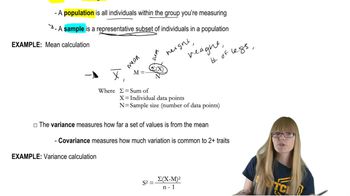Table of contents
- 1. Introduction to Genetics51m
- 2. Mendel's Laws of Inheritance3h 37m
- 3. Extensions to Mendelian Inheritance2h 41m
- 4. Genetic Mapping and Linkage2h 28m
- 5. Genetics of Bacteria and Viruses1h 21m
- 6. Chromosomal Variation1h 48m
- 7. DNA and Chromosome Structure56m
- 8. DNA Replication1h 10m
- 9. Mitosis and Meiosis1h 34m
- 10. Transcription1h 0m
- 11. Translation58m
- 12. Gene Regulation in Prokaryotes1h 19m
- 13. Gene Regulation in Eukaryotes44m
- 14. Genetic Control of Development44m
- 15. Genomes and Genomics1h 50m
- 16. Transposable Elements47m
- 17. Mutation, Repair, and Recombination1h 6m
- 18. Molecular Genetic Tools19m
- 19. Cancer Genetics29m
- 20. Quantitative Genetics1h 26m
- 21. Population Genetics50m
- 22. Evolutionary Genetics29m
2. Mendel's Laws of Inheritance
Probability and Genetics
Problem 19a
Textbook Question
If two six-sided dice are rolled, what is the probability that the total number of spots showing is
an odd number?
 Verified step by step guidance
Verified step by step guidance1
<span>Step 1: Understand the problem. We need to find the probability that the sum of the numbers on two six-sided dice is an odd number.</span>
<span>Step 2: Determine the total number of possible outcomes when two dice are rolled. Since each die has 6 faces, the total number of outcomes is 6 \times 6 = 36.</span>
<span>Step 3: Identify the condition for the sum to be odd. The sum of two numbers is odd if one number is even and the other is odd.</span>
<span>Step 4: Calculate the number of favorable outcomes. For each die, there are 3 even numbers (2, 4, 6) and 3 odd numbers (1, 3, 5). Consider the combinations: (even, odd) and (odd, even).</span>
<span>Step 5: Calculate the probability. Add the number of favorable outcomes from both combinations and divide by the total number of outcomes (36) to find the probability.</span>
Recommended similar problem, with video answer:
 Verified Solution
Verified SolutionThis video solution was recommended by our tutors as helpful for the problem above
Video duration:
1mPlay a video:
Was this helpful?
Key Concepts
Here are the essential concepts you must grasp in order to answer the question correctly.
Probability
Probability is a measure of the likelihood that a particular event will occur, expressed as a ratio of favorable outcomes to the total number of possible outcomes. In the context of rolling dice, it helps determine how likely it is to achieve a specific sum, such as an odd number, when two dice are rolled.
Recommended video:
Guided course

Probability
Outcomes of Rolling Dice
When rolling two six-sided dice, each die has six faces, leading to a total of 36 possible outcomes (6 faces on the first die multiplied by 6 faces on the second die). Each outcome corresponds to a unique combination of the numbers showing on the two dice, which is essential for calculating probabilities.
Recommended video:
Guided course

Probability
Odd and Even Sums
The sum of two numbers can be either odd or even. An odd sum occurs when one die shows an odd number and the other shows an even number. Understanding how to categorize the sums based on the parity of the numbers rolled is crucial for determining the probability of obtaining an odd total when rolling two dice.
Recommended video:
Guided course

Mathematical Measurements
Related Videos
Related Practice



